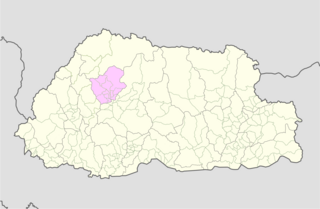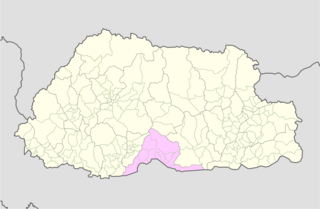Khatoed Goenkaatoe | |
|---|---|
| Coordinates: 27°50′N89°38′E / 27.833°N 89.633°E | |
| Country | |
| District | Gasa District |
| Time zone | UTC+6 (BTT) |
Khatoed is a gewog (village block) of the Gasa dzongkhag (district) in Bhutan. [1] It was formerly known as Goenkaatoe. [2]
Khatoed Goenkaatoe | |
|---|---|
| Coordinates: 27°50′N89°38′E / 27.833°N 89.633°E | |
| Country | |
| District | Gasa District |
| Time zone | UTC+6 (BTT) |
Khatoed is a gewog (village block) of the Gasa dzongkhag (district) in Bhutan. [1] It was formerly known as Goenkaatoe. [2]

Wangdue Phodrang District is a Thromde and dzongkhag (district) of central Bhutan. This is also the name of the dzong which dominates the district. The name is said to have been given by the Shabdrung Ngawang Namgyal who was searching for the best location for a dzong to prevent incursions from the south. The word "wangdue" means unification of Country, and "Phodrang" means Palace in Dzongkha.

Haa District is one of the 20 dzongkhag or districts comprising Bhutan. An alternative name for the district is "Hidden-Land Rice Valley." It the second least-populated dzongkhag in the country after Gasa.

The Kingdom of Bhutan is divided into 20 districts. Bhutan is located between the Tibet Autonomous Region of China and India on the eastern slopes of the Himalayas in South Asia.

Chukha District is one of the 20 dzongkhag (districts) comprising Bhutan. The major town is Phuentsholing.

Gasa District or Gasa Dzongkhag is one of the 20 dzongkhags (districts) comprising Bhutan. The capital of Gasa District is Gasa Dzong near Gasa. It is located in the far north of the county and spans the Middle and High regions of the Tibetan Himalayas. The dominant language of the district is Dzongkha, which is the national language. Related languages, Layakha and Lunanakha, are spoken by semi-nomadic communities in the north of the district. The People's Republic of China claims the northern part of Gasa District.

PemagatshelDistrict is one of the 20 Dzongkhags (districts) in Bhutan.

Punakha District is one of the 20 dzongkhags (districts) comprising Bhutan. It is bordered by Thimphu, Gasa, and Wangdue Phodrang Districts. The dominant language in the district is Dzongkha, the national language.

A gewog, in the past also spelled as geog, is a group of villages in Bhutan. The head of a gewog is called a gup. Gewogs form a geographic administrative unit below dzongkhag districts, and above Dzongkhag Thromde class B and Yenlag Thromde municipalities. Dzongkhag Thromde class A municipalities have their own independent local government body.

A dungkhag is a sub-district of a dzongkhag (district) of Bhutan. The head of a dungkhag is a Dungpa. As of 2007, nine of the twenty dzongkhags had from one to three dungkhags, with sixteen dungkhags in total.
Getena Gewog is a gewog of Chukha District, Bhutan. The 214-km² gewog contains 7 villages and 118 households.
Katsho Gewog is a gewog of Haa District, Bhutan. Before substantial border changes, the gewog in 2007 had an area of 42.3 square kilometres and contained 10 villages and 247 households.
Sangbay or Sangbaykha Gewog is a gewog of Haa District, Bhutan. It is one of the western gewogs of the Haa district sharing borders with the Samtse District, India's Sikkim state and China's Chumbi Valley. The latter border has been contested by China, which claims the Doklam region as its territory. In recent years, China has begun to build villages in its claimed area.

Hungrel Gewog is a gewog of Paro District, Bhutan. In 2002, the gewog had an area of 3.6 square kilometres and contained 17 villages and 247 households.
Khamaed is a gewog of the Gasa dzongkhag (district) in Bhutan. It was formerly known as Goenkhamae. Khamaed Gewog has a population of 1,057, which includes 562 men and 495 women.
Nichula Gewog is a gewog of Dagana District, Bhutan. It also comprises part of Lhamoy Zingkha Dungkhag (sub-district), along with Lhamoy Zingkha and Deorali Gewogs.

Umling Gewog is a gewog of Sarpang District, Bhutan.

Shumar Gewog is a gewog in Pemagatshel District, Bhutan.
The Local Government Act of Bhutan was enacted on September 11, 2009, by parliament of Bhutan in order to further implement its program of decentralization and devolution of power and authority. It is the most recent reform of the law on Bhutan's administrative divisions: Dzongkhags, Dungkhags, Gewogs, Chiwogs, and Thromdes (municipalities). The Local Government Act of Bhutan has been slightly amended in 2014.

A Thromde is a second-level administrative division in Bhutan. The legal administrative status of thromdes was most recently codified under the Local Government Act of 2009, and the role of thromdes in elections in Bhutan was defined in the Election Act of 2008.

Pemaling Gewog is a gewog of Samtse District, Bhutan. The gewog has an area of 49.04 square kilometres and contains 15 chewogs with 46 villages and 448 households. Pemaling Gewog comprises part of Tashicholing Dungkhag (sub-district), together with Tendu, Namgaychhoeling, Norgaygang, and Tashicholing Gewogs.